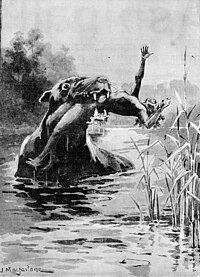
Back بونييب Arabic Бунайп Bulgarian বুনিপ Bengali/Bangla Bunyip Czech Bunyip Danish Bunyip German Bunyip English Bunyip Spanish Bunyip Basque Bunyip Finnish
| Bunyip | |
|---|---|
 | |
| Drawing of the legendary bunyip (1890) from the State Library of Victoria | |
| Creature | |
| Name: | Bunyip |
| Data | |
| Mythology: | Aboriginal Australian |
| First reported: | early 1800s |
| Country: | Australia |
| Habitat: | Swamps |
| Status: | Not proven real |
The bunyip is a mythical creature from Australian mythology. It is said to live in swamps, billabongs, creeks, riverbeds, and waterholes. The bunyip is found in traditional aboriginal beliefs and stories from many parts of Australia, although it is called by several different names in different language groups.[1] These include kianpraty along the Murrumbidgee,[2] wowee in the Hunter Valley, wee waa in the Narrandera region, as well as many other names.[3] The name bunyip comes from the Wemba-Wemba language of southeastern Australia.[4][5][6] It is normally translated today as "devil" or "evil spirit".[7]
During the early settlement of Australia by Europeans, the idea that the bunyip was an actual unknown animal that had yet to be discovered became common. A large number of bunyip "sightings" by settlers were recorded during the 1840s and 1850s, especially in Victoria, New South Wales and South Australia. Various written stories of bunyips were made by Europeans in the early and mid-19th century. Stories were commonly told to children to make them stay away from dangerous areas of water.
There are many different descriptions of what the bunyip looks like. Features that were often reported in newspapers in the early 19th-century included dark fur, a face like a dog, sharp teeth and claws, flippers, tusks or horns, and a duck-like bill.[8] One writer, Robert Brough Smyth, recorded many different descriptions of the bunyip. But he concluded that most people did not really know much about what it looked like or its behaviour, and that they were too afraid of the creature to be able to take note of its appearance.[9]
Scholars have suggested that the story of the bunyip may have been passed down from a time when megafauna still existed in Australia. Comparisons have been made to extinct marsupials like the Diprotodon or Thylacoleo.[10] Other scholars have suggested that people finding the fossilised remains of such animals would identify them as the bunyip.[11]
- ↑ Wannan 1970, p. 101
- ↑ Morris 1898, pp. 65–66
- ↑ Holden & Holden 2001, pp. 2–24
- ↑ Hughes 1989, p. 90
- ↑ Butler 2009, p. 53
- ↑ Holden & Holden 2001, p. 15
- ↑ See for example, Noonuccal 2006
- ↑ Ravenscroft 2009
- ↑ Smyth cited in Holden & Holden 2001, p. 175
- ↑ Holden & Holden 2001, p. 90
- ↑ Vikers-Rich et al. 1991, p. 2